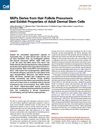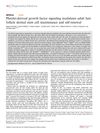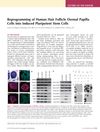Search
for
Did you mean Adult Stem Cells?
Learn
2 / 2 resultslearn Neem Oil
natural substance from Neem tree with medicinal and pesticidal properties
Research
5 / 1000+ results
research SKPs Derive from Hair Follicle Precursors and Exhibit Properties of Adult Dermal Stem Cells
SKPs are similar to adult skin stem cells and could help in skin repair and hair growth.
research Skipping a Hurdle: Sox2 and Adult Dermal Stem Cells
Sox2-expressing cells can help grow hair and heal skin.

research Diversity of Adult Stem Cell Niches in the Dermal Compartment of Skin
The skin's dermal layer contains true stem cells with diverse functions and interactions that need more research to fully understand.

research Platelet-Derived Growth Factor Signaling Modulates Adult Hair Follicle Dermal Stem Cell Maintenance and Self-Renewal
PDGF signaling is crucial for maintaining and renewing hair follicle stem cells, which could help treat hair loss.

research Reprogramming of Human Hair Follicle Dermal Papilla Cells into Induced Pluripotent Stem Cells
Human hair follicle cells can be successfully transformed into different types of cells, but not more efficiently than other adult cells.
Community Join
5 / 417 resultscommunity How ET-02 Works. Also no proof that it's better than Minoxidil. At least for now.
ET-02, a PAI-1 inhibitor, is not proven to be more effective than Minoxidil for hair loss. Other treatments like finasteride, dutasteride, PP405, and AMP-303 are also discussed, focusing on cellular senescence and oxidative stress.
community My Theory Of Androgenic Alopecia
Hair loss is linked to cellular physiology and the IGF-1 to TGF-B1 ratio, not just androgen sensitivity. The theory lacks evidence, while finasteride and minoxidil are effective treatments.
community CRISPR Is Curing People Right Now. Genetic Hair Loss is Next?
CRISPR shows promise for treating hair loss by targeting specific genes. Current treatments include Minoxidil and finasteride, but CRISPR could offer a more precise solution, though it is still expensive and in early stages.

community Compressed part of research of theory of androgenic/anabolitic balance. AGA h-responders analytic. Theory of physio-metabolitic method of anti AGA treatment
The treatment for androgenetic alopecia involves using finasteride and minoxidil with intense exercise and cold exposure to boost metabolism and reduce androgenic effects, potentially leading to hair regrowth. This approach may activate biological pathways for improved hair and overall health.
community The Real Cause Of Androgenetic Alopecia
Androgenetic alopecia is caused by DHT affecting hair growth. Finasteride and minoxidil are used to manage hair loss by blocking DHT and promoting hair growth.